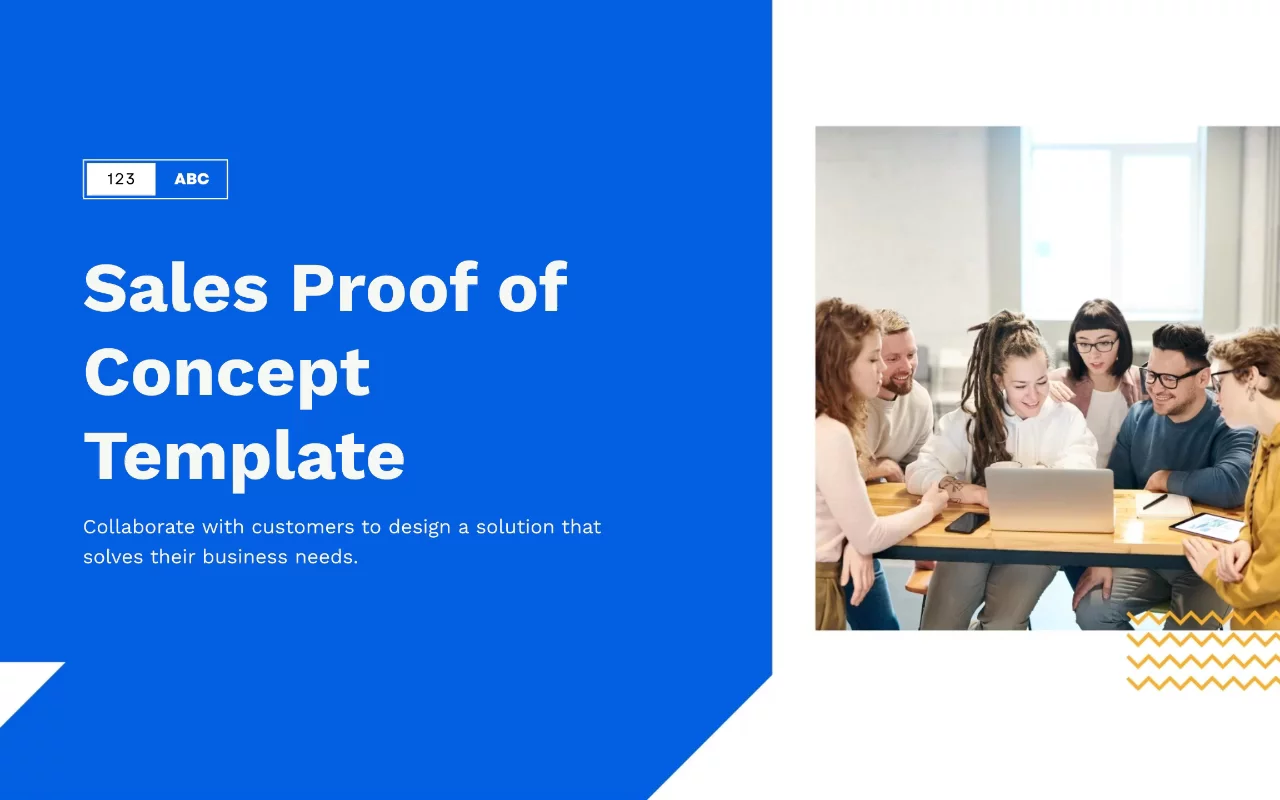Sales Proof of Concept Template
Demonstrate your solution's value with our effective Proof of Concept Template – create a detailed and professional proof of concept for prospects.

About this template
Impress the entire buying committee and manage complex enterprise sales cycles with an interactive and easy-to-use Enterprise Sales template. Our template ensures a seamless buying experience, helping your sales representatives close complex deals and win more business.
What's included?
- Overview
- Timeline of POC
- Success criteria
- Investment
- Solution
- Next steps
- ROI calculations
- Get started
- Contact us
- Book a meeting
About the author

Tania Clarke|Head of Product Marketing
Tania heads up product marketing at Qwilr – looking after positioning, sales enablement, competitor intelligence and more. Tania brings experience from former roles at high growth startups like Atlassian and Safety Culture.
A Proof of Concept is one of the most effective ways to demonstrate the feasibility of an idea or solution. A successful Proof of Concept will ultimately demonstrate your business’ products, services, or solutions in a sales context, providing a compelling business case for their adoption.
A Proof of Concept can often take the form of a document, presentation, or demo, highlighting the viability of an idea to potential buyers, investors, managers, and other stakeholders. In the case of Qwilr’s Proof of Concept template, it’s an interactive web-based proposal.
A Proof of Concept typically must feature a number of elements including but not limited to the following:
- Executive summary
- Business analysis
- Competitor analysis
- Customer feedback
- Projected financials
- Clear go-to-market strategy
The Proof of Concept approach is best used to confirm whether an idea (i.e. product, service, solution) is viable before investing in it.
Testing a proof of concept should be done before both parties make a financial commitment, ensuring both sides are equipped with all the relevant information (i.e costs, resources, obstacles) to transform an idea into reality.
A Proof of Concept is extremely popular for software development or SaaS companies, helping their buyer validate prior to significant investment.
A Proof of Concept template serves a number of purposes, from highlighting the cost of product development and financial projections to illuminating potential marketing strategies and revenue models.
But be wary, many POCs can drag on. Here's some great advice from Nate Nasralla, co-founder of Fluint:
"Reframe the paid trial as structuring a short, contained experiment. Because short and fast POCs aren’t just better for you (shorter cycle time). They’re an easier initial ask for the customer too. The next steps are how you keep POCs contained."
Nate Nasralla, co-founder of Fluint (source)
Qwilr’s Proof of Concept template offers businesses a number of benefits, but ultimately is designed to help sales teams close more deals. Notably, a Proof of Concept is effective at showcasing that your product or service is the right fit for prospective clients.
Testing a Proof of Concept equips your business with invaluable customer feedback, giving you the ability to improve your product offering. In doing so, this sales methodology builds trust and credibility with customers, ensuring their concerns are heard.
With Qwilr’s Proof of Concept template, sales representatives can create interactive and mobile-friendly demonstrations, creating an initial roadmap for the development of a product. This not only helps your sales team build confidence in their own ideas, but also helps them better understand potential risks, obstacles, as well as financial feasibility.
Here's a quick video overview of how to get started with this template:
Our Proof of Concept template equips your sales representatives for success, ensuring they are in the best position to demonstrate your product’s value. You can also book a demo if you are looking to get started with Qwilr!
- Create an interactive, mobile-friendly Proof of Concept document.
- Align multiple stakeholders within one collaborative document.
- Monitor buyer engagement and track every click through Qwilr analytics
- Clearly underline the steps of writing a Proof of Concept
- Identify a product’s feasibility including, projected financials and financial feasibility
- Empower your sales team to develop a clear go-to-market strategy
- Focus sales conversations on leads with a clear need for your solutions (i.e. higher motivation to close a deal)
- Simplify the buying experience by organizing all pertinent information in one interactive document
- Ability to embed further sales collateral, like videos or spreadsheets – avoid attachments and links getting lost in email chains.
- Guide buyers through the sales process
- Embed security and compliance information for a safe, streamlined, and reliable sales process
A tool packed with features
Brand control
Establish your brand settings once and automatically apply to every piece of collateral.
Payments
Collect payments instantly from customers with Stripe or direct to your own payment system.
Security & GDPR
Add security features like password protection and link expiry to protect sensitive content.
Embedded content
Add Calendly links, videos, surveys, Looms, GIFs and more to every page.
E-signature
Get deals signed on the spot with built-in e-signing ability.
Asset library
Create a library of reusable content for sales reps.
ROI calculator
Showcase your value with an interactive ROI calculator embedded in your Qwilr pages.
Team management
Set up permissions so your team accesses only what they need.
Interactive pricing
Empower buyers with interactive pricing plans and quotes.
Templates for every use case
Explore templates for sales, marketing, customer success, sales enablement and more.
Explore sales process templatesFrequently asked questions
A Proof of Concept is used by sales representatives to demonstrate how their products and services respond to a particular customer need. This sales methodology entails a demonstration of a product or service, underlining its financial feasibility. Ultimately, a Proof of Concept is the first step to determine whether an idea is worth pursuing, taking into account financial viability, potential obstacles, resources needed and a potential client’s timeline.
Proof of Concept templates can be used to identify the value of a product vis-a-vis customer use cases, offering a clear overview on costs, time frames, parameters, and requirements of product development.
A Proof of Concept is often used interchangeably with prototypes and Minimal Viable Products (MVP), however, key distinctions exist. A Proof of Concept is ultimately designed to determine whether an idea is feasible before developing a product, whereas a Prototype serves as a model of a product that can be tested, highlighting exactly how it works.
Minimal Viable Product (MVP), by contrast, is simply a refined version of a prototype, eliminating minor inefficiencies to deliver a final product. Finally, testing a Proof of Concept (PoC) is typically done before investing money and resources into a product, creating a case for its adoption based on user needs.
There are a number of reasons why it may make sense to include a Proof of Concept in your sales process. A Proof of Concept is ultimately designed to help the vendor (or seller) demonstrate their product or service’s competency. For example, if your a B2B SaaS solution that helps businesses prospect into larger enterprises, your proof of concept could be a test export of contacts/companies that demonstrates the accuracy and size of your database.
A secondary benefit of a Proof of Concept is that they help both the buyer and the seller validate that their is mutual benefit. For example, extending the above scenario, if you primarily sell in APAC but the prospecting solution is a US/UK focused platform, then a Proof of Concept can be a great way to identify early on that there in fact isn’t a good fit by directly diving into the practicalities of the solution.
There are five basic steps sales representatives must follow before developing a Proof of Concept.
- Demonstrate a need for the product: Sales reps must first establish a need for their product or service, identifying a target market and pain points.
- Brainstorming: Once potential pain points have been identified, sales teams can then begin brainstorming feasible solutions before developing a Proof of Concept.
- Evaluation: Is the solution feasible financially and can it be done according to the customer’s timeline?
- Proof of Concept Design: Create a viable Proof of Concept that addresses a lead’s business needs, leveraging customer feedback.
- Presentation: The finalized Proof of Concept template is presented to relevant stakeholders for approval, confirming its viability.
There are typically four steps involved when writing a Proof of Concept. Following these steps will increase the likelihood of closing more deals and winning more business with successful Proof of Concept templates. Here are the four steps to writing a Proof of Concept.
- Identify the problem you are trying to solve: How can your product or service solve a client’s problem, and is there a real need for it?
- Identify resources needed: Create an extensive list of all the resources you’ll need to successfully deploy the product. This helps businesses gain a better understanding of the overall cost of the project.
- Identify success metrics and KPIs: Simply put, what does a successful product deployment look like?
- Identify a timeline: When should the client expect the product to be delivered by?




